The Mongol Cultural Legacy in East and Central Asia: The Early Ming and Timurid Courts
IF 0.3
0 ASIAN STUDIES
引用次数: 20
Abstract
Following the fall of the Mongol Empire (c. 1206–1368) in both East and West Asia, Zhu Yuanzhang (Hongwu Emperor, r. 1368–1398), the founder of the Ming Dynasty (1368–1644) in China, Timur (r. 1370–1405), founder of the Timurid Empire (1370–1507) in Central Asia, and their successors used the legacy of the Chinggisid Mongols in different ways to lend an aura of power and legitimacy to their newly established courts. In this paper, I explore the cultural legacy of the Mongol Empire as manifested in the early Ming and Timurid courts, with a special interest in how continuing cultural exchange between the two courts impacted the arts produced in both places. In particular, I highlight how the ongoing incorporation of “foreign” motifs and techniques set the tone for the arts of both courts in the late fourteenth century.东亚和中亚的蒙古文化遗产:明初和帖木儿王朝
蒙古帝国(约1206-1368年)在东亚和西亚灭亡后,中国明朝(1368-1644年)的创始人朱元璋(洪武皇帝,1368-1398年),中亚帖木儿帝国(1370-1507年)创始人帖木儿(1370-1405年),他们的继任者以不同的方式利用了钦吉西蒙古人的遗产,为他们新成立的法院增添了权力和合法性的光环。在本文中,我探讨了明初和帖木儿王朝时期蒙古帝国的文化遗产,特别感兴趣的是这两个王朝之间持续的文化交流如何影响两地的艺术。特别是,我强调了“外国”图案和技术的不断融合如何为14世纪末的两个宫廷的艺术奠定了基调。
本文章由计算机程序翻译,如有差异,请以英文原文为准。
求助全文
约1分钟内获得全文
求助全文

 求助内容:
求助内容: 应助结果提醒方式:
应助结果提醒方式:


